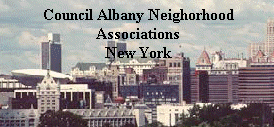With the exception of one apartment complex, this downtown
neighborhood is a charming collection of mostly urban one- and
two-family houses that form an attractive patchwork of muted
colors. It's located within walking distance of services,
shopping, restaurants and the Empire State Plaza. And the
residents take advantage of the area's location: You see people
everywhere -- on bicycles, on in-line skates and on foot.
The people are from all walks of life, a fact many residents
find appealing.
"We kept coming back to this neighborhood seven years
ago because it's so diverse," says Marcus Pryor, president
of Peter M. Pryor Associates in Albany and a founding member of
the Central Avenue Business Improvement District. At the time,
Pryor and his wife, Elizabeth, were expecting a baby, and they
both wanted their child to grow up in a diverse environment.
"This neighborhood has exceeded my expectations,"
says Pryor, who lives across from the Capital Gay and Lesbian
Community Center. "Albany is often a small city in more
than just population, but this is truly a homey neighborhood,
where you know your neighbors and your neighbors are like
family."
It's a stable neighborhood populated by a mix of students,
professionals, state workers and retirees. In addition to
diversity in employment, ethnicity and sexuality, the income
levels of residents range from welfare recipients to
millionaires.
Hudson Park is bounded by Hudson Avenue on the north, Swan
Street to the east, Park Avenue to the south and Delaware Avenue
to Madison Avenue and Willett Street to Hudson Avenue on the
west.
Homes from Hudson Avenue to Madison Avenue are larger brick,
brownstone and clapboard structures. Houses south, east and west
of Madison tend to be smaller and predominantly clapboard.
Architectural details add character to the homes, and many of
the row houses are decorated with seasonal wreaths or potted
plants. Some residents have added plantings to the small open
spaces between the sidewalks and the streets.
Many of the tree-lined streets have been blacktopped, but a
few brick and cobblestone roads remain, a testament to the
historic character of this 19th-century neighborhood.
Some of the houses backing onto Garden Alley have garages,
but most residents have to be content with on-street parking.
A major part of the neighborhood was considered for
demolition in the late 1960s when early plans called for an
interchange tunnel under Washington Park, connecting Northern
Boulevard (now Henry Johnson Boulevard) with the Empire State
Plaza tunnel at the foot of Hudson Avenue and Jay Street.
The plan was scrapped and shortly thereafter many of the
houses in the neighborhood were refurbished with both grants and
private funding.
Gordon "Mac" Mowbray is one of six or so remaining
residents who founded the Hudson Park Neighborhood Association
in 1975.
"The Center Square Association ended a block away at Jay
Street and with the construction of the plaza, there were a lot
of issues that were unique to us, and we knew that we didn't
want our neighborhood torn down," recalls Mowbray, who has
lived in the Hudson Park neighborhood for 34 years.
"Neighborhood associations were more effective than the old
ward leaders association."
Mowbray describes the people of Hudson Park to be very
neighborly, but not nosy. Even though there is an element of
privacy, people are still willing to be there when you need
them.
"If your car is stuck in the snow, four people will come
out to help dig you out," Mowbray says. "The
neighborhood association helps to keep us strong and
united."
Social events abound in the neighborhood, such as a barbecue
at the end of an annual spring clean-up.
The Blue Moon Dinner is held to award prizes to those who
have contributed to the neighborhood, and there's an annual
brunch in February to recruit new association members. There are
several events in August, including a barbecue for National
Night Out Neighbors Against Drugs and a
get-to-know-your-neighbors barbecue.
An annual Christmas party take place a local restaurant, and
an annual garden tour is held in conjunction with the Center
Square Association and Historic Albany Foundation.
The ambience of the neighborhood is also a big draw.
"I love being able to see my neighbors everyday,"
says resident Ellen Picotte, a real estate agent with Prudential
Manor Homes in Delmar. "It's great to be able to walk
everywhere and to jog around Washington Park. I also love the
architecture and the history.
"But when you retreat to your backyard with these huge
trees, you feel like you're in the country and then walk out the
front door to the hustle and bustle of the city. It's the best
of both worlds."
At a glance
Real estate values: Approximately $100,000 to $300,000.
Schools: Giffen Memorial School, K-5; William S. Hackett
Middle School, 6-8; Albany High School, 9-12.
Taxes: Properties are assessed at full value. Residents pay
$14.75 per $1,000 of assessed value for city and county and $23
per $1,000 of the assessed value for school and library. Taxes
on a $163,000 home would be approximately $6,153.
